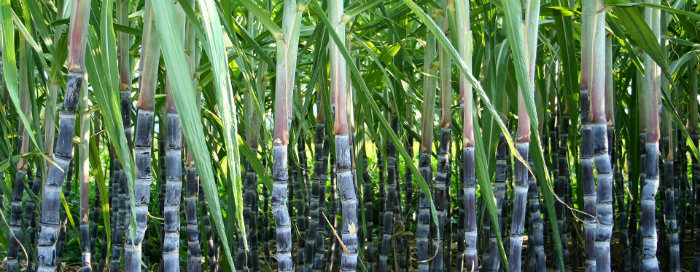Brazil is the leader by far among the sugar producing (37.2 million Tonnes) and exporting (25.2 million Tonnes) countries. The total traded sugar world-wide amounts to 53 million Tonnes. Thailand is the second largest exporter with 5.1 million Tonnes and third is Australia with 3.6 million Tonnes. Other leading producers include India, the EU and China. Prices are high, being influenced not only by an annual increase in consumption (c.a. 1.5%) but also from the rise of use of ethanol as a biofuel.
- Taxonomy:
- Family:
- Poaceae
- Occurrence & Agricultural Importance in this Country:
- Cultivation Areas:
- Sudan is the third sugar producer in Africa after South Africa and Egypt. Around 1 Million Tonnes of sugar per year is produced out of which about 0.2 million Tonnes per year is exported. However, the country is deficient in sugar as the annual consumption in Sudan reaches 1.6 million Tonnes per year. In general there is great potential in both sugar and ethanol production. Exports of ethanol have already taken place since 2009.
Most of the world’s sugarcane is grown between 22°N and 22°S but sometimes as North as 33° and 33° South. Sugarcane is a C-4 plant grown for 12+ months. Therefore, sugarcane produces higher yields of sugar than sugar beet which makes it the basic sugar crop in tropical regions.
- Main Varieties:
- Local Sudanese sugarcane varieties include: BJ9738, BJ82105, BT74209, CoC 671 and TUC 75-3. Many other sugar cane clones have been introduced in Sudan from various countries including the Caribbean, Latin America and even South-east Asia.
- Marketing Information and Uses:
In Sudan average yields of about 100 Tonnes per Ha have been reported which corresponds to about 9.7 Tonnes of sugar per Ha. - Use:
- Sugar cane is a major crop used in several industries. Apart from basic production of sugar and ethanol, production but also processed into juice, molasses, animal feed, paper and panel boards. Sugarcane is one of the most efficient crops in terms of photosynthesis as it is able to convert up to 2% of incident solar radiation into biomass.
- Crop Management:
Cultivation conditions and methods: - Soil Type:
- The highest yields are usually achieved on loamy or clay soils which are sufficiently air and water permeable, rich in nutrients. Sugarcane grows and develops better in soils with a neutral pH (6.5 to 7).
- Temperatures:
- Sugar cane cultivation requires a tropical or subtropical climate. Throughout the vegetative stage the optimum day temperature is 25 to 30 °C. Lower temperatures (15-18 °C) result in growth retardation. Over the late crop stages (2-3 months) sugar accumulates more rapidly at temperature levels around 18-22 °C.
- Water Requirements:
- The crop requires a minimum of 600 mm of rainfall equivalent. In Sudan flood irrigation is mainly used and the plant requires different amount of water during the different growth & development stages and the different growing seasons. The adjustment of water supply to the crop is a key factor that influences productivity.
- Nutrition Requirements:
- Soil should be subject to soil analysis for nutrient availability.
- Harvesting Period:
- Sugarcane is first harvested 10-12 months after the establishment of the plantation. Plantations are normally re-planted every 5 years although it is possible to retain a plantation for up to 10 years.
- Harvesting Methods:
- Mechanical
Source https://www.sudan.cropscience.bayer.com/ar/Crops/Sugarcane.aspx

